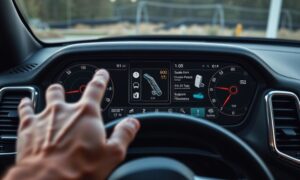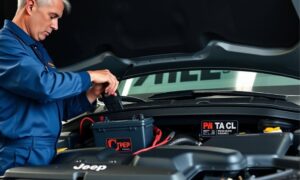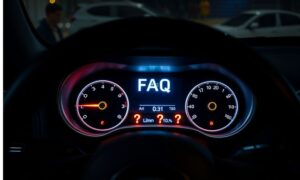Is your Jeep Grand Cherokee acting up? Strange warning lights, erratic behavior, or unexplained glitches can turn your smooth ride into a frustrating experience. These issues often stem from a simple source: your vehicle’s computer system needs a reset.
Don’t worry, though! Resetting your Jeep Grand Cherokee’s computer isn’t as daunting as it sounds. In fact, it’s a straightforward process that you can do at home, saving time and money on unnecessary trips to the mechanic. Whether you’re dealing with a check engine light that won’t go away or trying to clear adaptive memory after making repairs, a computer reset might be just what your Jeep needs to get back on track.
In this guide, we’ll walk you through the step-by-step process of resetting your Jeep Grand Cherokee’s computer. From understanding the basics of your vehicle’s electronic brain to exploring various reset methods and post-reset procedures, we’ve got you covered. So, buckle up and prepare to give your Jeep a fresh digital start!
Understanding the Jeep Grand Cherokee Computer System

A. Function of the onboard computer
The onboard computer in a Jeep Grand Cherokee, also known as the Powertrain Control Module (PCM) or Engine Control Unit (ECU), is the brain of your vehicle. It manages and controls various systems to ensure optimal performance, fuel efficiency, and emissions control. Some key functions include:
-
Engine management
-
Transmission Control
-
Fuel injection regulation
-
Emissions monitoring
-
Diagnostic capabilities
The PCM continuously receives data from numerous sensors throughout the vehicle, processes this information, and adjusts various systems accordingly. This real-time monitoring and adjustment help maintain the Jeep’s performance and efficiency under different driving conditions.
B. Signs indicating a computer reset is needed
Several symptoms may indicate that your Jeep Grand Cherokee’s computer needs a reset:
-
Check Engine Light: A persistent or intermittent illumination of this warning light
-
Erratic idle: Fluctuating RPMs or rough idling when stationary
-
Poor fuel economy: Sudden decrease in miles per gallon
-
Transmission issues: Delayed or harsh shifting
-
Stalling or misfiring: Engine cutting out unexpectedly or running roughly
Here’s a comparison of normal vs. problematic behavior:
| Aspect | Normal Behavior | Problematic Behavior |
|---|---|---|
| Idle | Smooth, consistent | Rough, fluctuating |
| MPG | Consistent with specs | Sudden decrease |
| Shifting | Smooth, timely | Delayed, harsh |
| Engine | Runs smoothly | Stalls, misfires |
C. Benefits of resetting the computer
Resetting the Jeep Grand Cherokee’s computer can offer several advantages:
-
Clear error codes: Eliminates stored fault codes that may be causing warning lights
-
Improved performance: Allows the PCM to relearn and optimize engine parameters
-
Better fuel efficiency: Resets adaptive learning for more accurate fuel metering
-
Smoother operation: Can resolve minor drivability issues and rough idling
-
Diagnostic aid: Helps determine if problems are persistent or temporary
By resetting the computer, you’re essentially giving your Jeep a fresh start. The PCM will relearn your driving habits and environmental conditions, potentially resolving issues that have developed over time. However, it’s important to note that resetting the computer is not a cure-all solution. If underlying mechanical problems exist, they will likely resurface after the reset.
Now that we understand the function of the Jeep Grand Cherokee’s computer system, the signs that indicate a reset might be necessary, and the potential benefits of performing a reset, let’s move on to preparing for the reset process. This crucial step ensures that you have everything you need and take the necessary precautions before beginning the procedure.
Preparing for the Reset Process

A. Gathering necessary tools
Before you begin the process of resetting your Jeep Grand Cherokee’s computer, it’s crucial to have all the necessary tools at hand. This preparation will ensure a smooth and efficient reset process. Here’s a list of essential tools you’ll need:
-
Wrench or socket set (to disconnect the battery)
-
Insulated gloves
-
Safety glasses
-
Fuse puller
-
Flashlight
-
Owner’s manual
-
Clean, dry cloth
| Tool | Purpose |
|---|---|
| Wrench or socket set | To loosen and tighten battery terminals |
| Insulated gloves | Protection against electrical shock |
| Safety glasses | Eye protection |
| Fuse puller | Safe removal of fuses |
| Flashlight | Illumination in dark areas |
| Owner’s manual | Reference for specific instructions |
| Clean, dry cloth | Cleaning battery terminals |
B. Safety precautions
Resetting your Jeep Grand Cherokee’s computer involves working with electrical components, so safety should be your top priority. Follow these precautions:
-
Ensure the vehicle is parked on a level surface with the parking brake engaged.
-
Turn off the engine and remove the key from the ignition.
-
Wear insulated gloves and safety glasses throughout the process.
-
Avoid wearing metal jewelry or loose clothing that could accidentally come into contact with electrical components.
-
Work in a well-ventilated area, as batteries can emit harmful gases.
-
Keep a fire extinguisher nearby as a precautionary measure.
C. Locating the battery and fuse box
Now that you’re prepared and aware of safety measures, it’s time to locate the key components:
-
Battery location:
-
In most Jeep Grand Cherokee models, the battery is under the hood.
-
Open the hood and secure it with the prop rod.
-
The battery is typically on the driver’s side, near the front of the engine compartment.
-
-
Fuse box location:
-
The main fuse box is usually under the hood, often on the driver’s side.
-
There may be an additional interior fuse box, typically found under the dashboard on the driver’s side.
-
It’s important to consult your owner’s manual for the exact locations, as they may vary slightly depending on the model year of your Jeep Grand Cherokee.
With these preparations, you’re now ready to move on to the reset process. Remember, gathering your tools, understanding safety precautions, and locating key components will make the reset procedure much smoother and safer. In the next section, we’ll dive into the step-by-step process of disconnecting the battery to begin the computer reset.
Disconnecting the Battery

A. Identifying the correct Battery Terminals
Before disconnecting the battery to reset your Jeep Grand Cherokee’s computer, it’s crucial to identify the correct battery terminals. The battery is typically located in the engine compartment, often on the driver’s side.
-
Positive terminal: Marked with a “+” sign and usually colored red
-
Negative terminal: Marked with a “-” sign and usually colored black
| Terminal | Marking | Color |
|---|---|---|
| Positive | + | Red |
| Negative | – | Black |
Always double-check the markings to avoid any confusion. Incorrect identification can lead to serious electrical issues or even damage to your vehicle’s computer system.
B. Proper order of disconnection
When disconnecting the battery for a Jeep Grand Cherokee computer reset, following the correct order is essential:
-
Locate the negative terminal (black, marked with “-“)
-
Use a wrench to loosen the nut on the negative terminal
-
Carefully remove the negative cable from the terminal
-
Repeat the process for the positive terminal (red, marked with “+”)
This order minimizes the risk of short circuits and ensures a safe disconnection process. Remember to keep the disconnected cables away from metal surfaces to prevent accidental contact.
C. Waiting period for complete discharge
After disconnecting the battery, allowing sufficient time for the Jeep Grand Cherokee’s computer system to fully discharge is crucial. This step is vital for a complete reset of the ECU (Engine Control Unit) or PCM (Powertrain Control Module).
Recommended waiting periods:
-
Minimum: 15 minutes
-
Optimal: 30 minutes
-
For stubborn issues: Up to 1 hour
During this waiting period, you can perform the following actions to ensure a thorough discharge:
-
Turn the ignition key to the “On” position (without starting the engine)
-
Press the brake pedal several times
-
Turn on and off various electrical components (lights, radio, etc.)
These actions help drain any residual power in the system, ensuring a more effective reset of the Jeep Grand Cherokee’s computer.
Now that we’ve covered the proper disconnection process and waiting period, we’ll move on to discussing the reset procedure via fuse removal, which can be an alternative or complementary method to battery disconnection.
Resetting via Fuse Removal

Locating the engine control module fuse
Now that you’ve disconnected the battery, the next step in resetting your Jeep Grand Cherokee’s computer is to locate the engine control module (ECM) fuse. This fuse is crucial for the ECM’s operation; removing it is an effective way to reset the system.
To find the ECM fuse:
-
Locate the fuse box, typically under the hood or in the driver’s side footwell
-
Consult your vehicle’s manual for the exact location of the ECM fuse
-
Use the fuse diagram on the fuse box cover to identify the correct fuse
-
Look for labels such as “ECM,” “PCM,” or “Engine Control”
Safely removing the fuse
Once you’ve located the ECM fuse, it’s important to remove it safely to avoid damaging the electrical system or injuring yourself. Follow these steps:
-
Ensure the vehicle is completely powered off
-
Use a fuse puller tool if available, or clean, dry hands
-
Grip the fuse firmly and pull straight out with steady pressure
-
Inspect the fuse for any signs of damage or burning
| Do’s | Don’ts |
|---|---|
| Use proper tools | Use metal tools |
| Pull straight out | Wiggle or twist the fuse |
| Work with clean, dry hands | Touch other components |
| Double-check fuse identification | Rush the process |
Recommended duration for fuse removal
The duration for which you should remove the fuse is crucial for an effective reset. Here’s what you need to know:
-
Minimum time: 15 minutes
-
Optimal time: 30 minutes
-
Maximum time: 1 hour
Keeping the fuse out for at least 15 minutes ensures that all residual power in the system is drained, allowing for a complete reset of the ECM. However, leaving it out too long is unnecessary and may cause inconvenience.
Reinstalling the fuse correctly
After the appropriate time has passed, it’s time to reinstall the fuse. This step is just as important as removing it:
-
Align the fuse with its slot, ensuring the correct orientation
-
Push the fuse in firmly until it’s fully seated
-
Verify that the fuse is secure and not loose
-
Double-check that you’ve used the correct amperage fuse
Remember, improper installation can lead to electrical issues or prevent the ECM from functioning correctly. Take your time and be precise with this step.
With the fuse properly reinstalled, you’re now ready to move on to reconnecting the battery. This fuse removal and reinstallation process is a key part of resetting your Jeep Grand Cherokee’s computer system, addressing issues like error codes, performance problems, or other electronic glitches that may have been plaguing your vehicle.
Reconnecting the Battery

A. Proper order of reconnection
When reconnecting the battery in your Jeep Grand Cherokee, following the correct sequence is crucial to avoid potential damage to the vehicle’s electrical systems. Here’s the proper order:
-
Ensure the ignition is off
-
Connect the positive (+) terminal first
-
Connect the negative (-) terminal second
-
Tighten both connections securely
This order helps prevent short circuits and protects sensitive electronic components. Always wear safety gloves and use insulated tools when handling battery connections.
B. Verifying secure connections
After reconnecting the battery, verifying that all connections are secure is essential. Follow these steps:
-
Visually inspect both terminals for proper alignment
-
Gently wiggle each connection to ensure there’s no movement
-
Check for any signs of corrosion or damage on the terminals
-
Ensure the battery is firmly seated in its tray
A loose connection can cause intermittent electrical issues or even prevent the vehicle from starting. Take the time to double-check your work.
C. Initial system checks after reconnection
Once the battery is securely reconnected, perform these initial system checks:
-
Turn the key to the “On” position without starting the engine
-
Observe the dashboard lights and gauges for proper functionality
-
Start the engine and listen for any unusual noises
-
Check all electrical systems (lights, radio, power windows, etc.)
Here’s a table summarizing the key steps and potential issues to watch for:
| Step | Action | Potential Issues |
|---|---|---|
| 1 | Turn the key to “On” | No dashboard lights |
| 2 | Observe dashboard | Flickering or non-functional gauges |
| 3 | Start engine | Difficulty starting, unusual sounds |
| 4 | Check electrical systems | Non-functioning components |
If you encounter any issues during these checks, it may indicate an incomplete reset or a more serious electrical problem. In such cases, consider using a diagnostic tool or seeking professional assistance.
Remember that some systems may require recalibration or relearning procedures after reconnecting the battery. For example:
-
Power windows may need to be reset
-
Radio presets might be lost
-
Clock and date settings will likely need to be adjusted
The engine control module (ECM) may also need time to relearn idle and shift points. This process typically occurs automatically as you drive the vehicle, but you may notice slight differences in performance for the first few miles.
With the battery successfully reconnected and initial checks completed, your Jeep Grand Cherokee should be ready for normal operation. However, taking a short test drive is advisable to ensure all systems function correctly and allow the ECM to begin relearning.
Alternative Reset Methods
A. Using an OBD-II scanner

One of the most effective alternative methods for resetting your Jeep Grand Cherokee’s computer is by using an OBD-II scanner. This device connects directly to your vehicle’s onboard diagnostic port, allowing you to access and manipulate various systems within your Jeep’s computer.
To reset your Jeep Grand Cherokee’s computer using an OBD-II scanner:
-
Locate the OBD-II port (usually under the dashboard on the driver’s side)
-
Plug in the scanner
-
Turn on the ignition without starting the engine
-
Follow the scanner’s menu to find the reset option
-
Select the reset function and wait for the process to complete
Using an OBD-II scanner offers several advantages:
-
Precision: It allows for targeted resets of specific systems
-
Diagnostics: Many scanners can also read error codes, helping you identify issues
-
User-friendly: Most modern scanners have intuitive interfaces
| OBD-II Scanner Type | Pros | Cons |
|---|---|---|
| Basic Code Readers | Affordable, Easy to use | Limited functionality |
| Mid-Range Scanners | More features, Bluetooth connectivity | Higher cost |
| Professional Scanners | Comprehensive diagnostics, Advanced reset options | Expensive, May require training |
B. Driving cycle reset technique
The driving cycle reset technique is a natural way to reset your Jeep Grand Cherokee’s computer without special tools. This process involves driving your vehicle through a specific sequence of operations that allows the computer to relearn and recalibrate various parameters.
To perform a driving cycle reset:
-
Start with a cold engine (sit overnight)
-
Drive for 10-15 minutes at steady highway speeds
-
Allow the vehicle to idle for about 5 minutes
-
Accelerate moderately to 55 mph and maintain for 5-6 minutes
-
Decelerate without braking
-
Repeat steps 4-5 at least three times
This method is particularly effective for resetting emission-related parameters and can help clear certain check engine lights. However, it may not address all computer-related issues and can be time-consuming.
C. Dealership reset options
For more complex issues or when other methods fail, visiting a Jeep dealership for a professional reset might be necessary. Dealerships have access to proprietary diagnostic tools and software that can perform comprehensive resets and updates to your Jeep Grand Cherokee’s computer system.
Dealership reset options include:
-
Full system scan and reset
-
Software updates
-
Calibration of specific modules
-
Addressing manufacturer-specific issues
While dealership resets are the most thorough option, they can also be the most expensive. However, this method ensures that your Jeep’s computer system is reset and updated according to the manufacturer’s latest specifications for newer models or complex electronic issues.
Now that we’ve explored these alternative reset methods, it’s important to understand what steps to take after resetting your Jeep Grand Cherokee’s computer system.
Post-Reset Procedures
Allowing the computer to relearn
After resetting your Jeep Grand Cherokee’s computer, it’s crucial to allow the system to relearn and adapt to your driving habits. This process, known as the “drive cycle,” helps the computer gather essential data to optimize performance and fuel efficiency. During this period:
- Drive your vehicle normally for about 50-100 miles
- Avoid aggressive acceleration or braking
- Vary your speed and routes to expose the computer to different driving conditions
- Be patient, as it may take several days for the computer to adapt fully
Remember, the relearning process is automatic, and you don’t need to take any specific actions beyond regular driving.
Monitoring vehicle performance
Once you’ve reset the Jeep Grand Cherokee’s computer, it’s essential to closely monitor your vehicle’s performance to ensure the reset was successful and to identify any potential issues. Pay attention to the following aspects:
| Performance Aspect | What to Look For |
|---|---|
| Engine behavior | Smooth idling, consistent acceleration |
| Fuel efficiency | Improved or stabilized MPG |
| Transmission shifts | Smooth gear changes |
| Warning lights | Absence of check engine or other warning lights |
| Overall drivability | Improved responsiveness and handling |
Keep a log of any changes or improvements you notice in your Jeep’s performance. This information can be valuable if you need to consult with a mechanic or dealership later.
Addressing persistent issues
If you continue to experience problems with your Jeep Grand Cherokee after resetting the computer and allowing for the relearning process, it may indicate more serious underlying issues. In such cases, consider the following steps:
- Use an OBD-II scanner to check for any diagnostic trouble codes (DTCs)
- Consult your vehicle’s manual for specific troubleshooting steps
- Check for any recent software updates for your Jeep’s computer system
- Inspect and clean battery terminals and connections
- Verify that all fuses are properly seated and functioning
If problems persist, it’s advisable to seek professional help. A certified Jeep technician can perform a more thorough diagnosis and address any complex issues that may be affecting your vehicle’s computer system.
Now that you’ve completed the post-reset procedures, it’s important to understand that while resetting the computer can resolve many issues, it’s not always a cure-all solution. In some cases, you may need to explore alternative reset methods or seek professional assistance to fully resolve persistent problems with your Jeep Grand Cherokee’s computer system.
FAQs
1. How often should I reset my Jeep Grand Cherokee’s computer?
Resetting your Jeep Grand Cherokee’s computer isn’t a routine maintenance task. It’s typically only necessary when:
-
You’ve replaced a major component
-
You’re experiencing persistent electrical issues
-
The check engine light won’t clear after fixing a problem
Generally, you shouldn’t need to reset the computer more than once every few years.
2. Will resetting the computer erase my radio presets and other settings?
Resetting the Jeep Grand Cherokee’s computer will likely erase your radio presets, clock settings, and other personalized configurations. It’s a good idea to note these settings before performing a reset. Here’s a quick checklist:
-
Radio presets
-
Clock settings
-
Seat position memory (if applicable)
-
Climate control preferences
-
Trip computer data
3. Can I reset the computer without disconnecting the battery?
While disconnecting the battery is the most common method, there are alternative ways to reset the computer:
-
Using an OBD-II scanner
-
Removing specific fuses
-
Pressing and holding certain buttons on the dashboard
However, the battery disconnect method is generally the most effective and comprehensive.
4. How long does it take for the computer to reset fully?
The reset process itself is quick, but the computer needs time to relearn various parameters. Here’s a typical timeline:
| Phase | Duration | Description |
|---|---|---|
| Reset | 15-30 minutes | Time for a battery to be disconnected |
| Initial startup | 5-10 minutes | Computer performs self-checks |
| Relearning | 50-100 miles of driving | The computer adjusts to driving patterns |
5. Will resetting the computer fix my check engine light?
Resetting the computer can temporarily clear the check engine light, but it’s not a fix for underlying issues. Here’s what you need to know:
-
If the problem still exists, the light will likely come back on after a few drive cycles
-
Always diagnose and fix the root cause before resetting
-
Use an OBD-II scanner to read error codes before resetting
-
If the light returns immediately, there may be a serious issue requiring professional attention
Remember, resetting the Jeep Grand Cherokee’s computer should be seen as a troubleshooting step, not a solution in itself. Always address the underlying issues to ensure your vehicle runs smoothly and efficiently.
Conclusion

Resetting your Jeep Grand Cherokee’s computer system is a straightforward process that can resolve various electronic issues and improve your vehicle’s performance. Following the steps outlined in this guide, from understanding the computer system to disconnecting the battery and using alternative reset methods, you can effectively reset your Jeep’s computer and restore its optimal functionality.
Remember always to prioritize safety when working with your vehicle’s electrical system. If you’re unsure about any step in the process, don’t hesitate to consult a professional mechanic. Regular maintenance, including occasional computer resets, can help keep your Jeep Grand Cherokee running smoothly for years to come. Take charge of your vehicle’s performance and enjoy a smoother, more reliable driving experience.

Hello there, this is Thomas Byrd. I am a professional car mechanic who leads a team of junior mechanics in a repair and restoration shop. In the beginning, I used to work for a jeep service center as a basic worker. From there I keep learning, changed my job 2 times and now I am a professional who leads a group of mechanics. Though a have expertise in the jeep, I know very well about all types of cars. To share my knowledge and skills with others I have created this blog website. Whenever I get free time from work I give my time to my blog.


